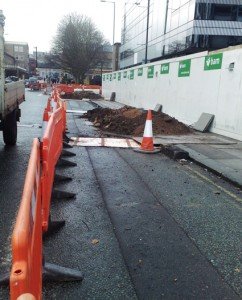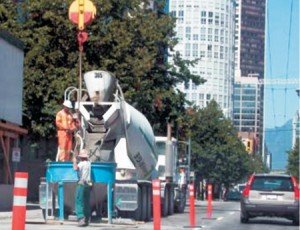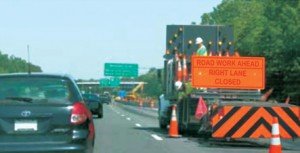Safety of construction crew and general public is important at the work sites of public transport projects. Since these are often mega projects, detailed planning is as important as effecting implementation of safety norms. A few examples of the US states show how such planning helps.
 Since transportation is the bloodline of every economy, it is necessary to build roads, bridges, railway lines, airports and waterways under mega public projects. Though it is important to prepare and plan well before implementing the projects so as to meet the deadlines and not exceed the budget, it is also important to take care that no life – either of the construction crew or of public – is lost in, or near, a public project work zone.
Since transportation is the bloodline of every economy, it is necessary to build roads, bridges, railway lines, airports and waterways under mega public projects. Though it is important to prepare and plan well before implementing the projects so as to meet the deadlines and not exceed the budget, it is also important to take care that no life – either of the construction crew or of public – is lost in, or near, a public project work zone.
Public projects in the transportation sector include all types of infrastructure facilities such as roads, intersections, freeways, light rail transit (LRT), bus rapid transit (BRT) and heavy rail projects, including metro stations and airports. Depending on the size of the project, the planning and programming exercise needs to be decided. The bigger the project, the minutest will be the attention to details. Big projects like Namma Metro of Bangalore or Delhi Metro of the national capital need every minute detail of the logistics to be worked out on the table before the crew gets down to work. And such planning often takes months.
Public agencies (applies to consultants building projects for public agencies as well) should pay attention to three major aspects before commencing work on a public project. The safety of work zone, traffic diversion and public information.
Safety of construction crew and general public
Majority of public projects involve large finances and long schedules for completion, particularly if they are for building new metro lines, airports and highways. For construction purposes, it is important to look at the project from the point of view of the builder (construction people at the project site) and the people who are already near the project site (the public). The safety of all the people near the project site becomes extremely important. Therefore, work zone safety needs to be the cornerstone of any planning and programming exercise. Proper training should be provided to all personnel involved in the project to understand the importance of safety. Any negligence or mishap at the site leading to loss of life can paralyse the project for years (through court cases) and even lead to the abandonment of the project. Strong measures need to be taken for safety on the sites unless and until the project site is so isolated that there is no public intervention or involvement.
Let us take a look at the projects that run through areas that already have constructed structures and where there is public movement – just like the Bangalore Metro or Delhi Metro which are surrounded by commercial, residential and mature roadway network used daily by the local public. The responsibility of safety falls on both – the public agency conducting the project and the public near the project work zone. But the public agency has an obligation to make the work zone area safe for both – the construction workers and the public near the work site.
Safety of work zone
The Work Zone Safety and Mobility Rule as prepared by the Federal Highway Administration (FHWA) in the United States clearly specifies that agencies require appropriate training for personnel involved in the development, design, implementation, operation, inspection and enforcement of work zone related transportation management and traffic control. Each state prepares work zone safety manual depending on the local conditions to be implemented for each public project before inception. In addition, the Work Zone Safety Grants programme by FHWA provides highway work zone safety training and develops guidelines to prevent and reduce work zone injuries and fatalities. Many courses and materials have been developed as part of the Work Zone Safety Grants programme.
In order to create a safe work zone during a public project, it is necessary to implement proper law and order near the site for the public. For this, FHWA has developed a training course that provides basic knowledge to promote the safe and effective use of law enforcement in work zones. As a result, the participants will understand the role of law enforcement officers in work zones, recognise proper practices and procedures related to the use of law enforcement officers in work zones, recognise the component parts of a typical work zone and understand the standards and guidelines related to temporary traffic control in work zones.
Depending on the time of day when the construction work takes place – day time or night time – specific precautions need to be taken. While the day time poses the challenge of heavy traffic and other hazards, night time brings with it the problem of low visibility and many other problems. So, it is essential that the staff is trained to handle both types of situations. During construction at night time, it is essential to have proper lighting and signages throughout the work zone area to avoid accidents.
For example, it is necessary for all workers working in the project area to wear high – visibility safety apparel. This has been specified in the Manual of Uniform Traffic Control Devices (MUTCD). Many of the accidents happen due to poor visibility while workers are standing in front or back of moving equipment within the project area. Figure 1 shows workers fixing a road with new asphalt; wearing apparel and hard hats that are recognisable by the public. Appropriate traffic diversion cones are placed to separate the work zone from the main traffic lanes on the roadway. Figure 2 shows the use of proper signs in the work zone. Visible flashing arrow lights are used to show the diversion for the motorists. The figure also illustrates the proper use of traffic diversion cones and safety precautions by workers using “hard hats” in the work zone. The source for both the figures is the US Department of Transportation, FHWA Work Zone Safety and Temporary Traffic Control and Operations.
 TrafficInfraTech Magazine Linking People Places & Progress
TrafficInfraTech Magazine Linking People Places & Progress

